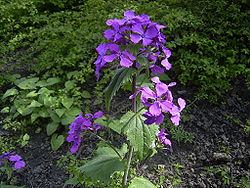| Lunaria | |
|---|---|
 | |
| L. annua | |
| Scientific classification | |
| Kingdom: | Plantae |
| Clade: | Tracheophytes |
| Clade: | Angiosperms |
| Clade: | Eudicots |
| Clade: | Rosids |
| Order: | Brassicales |
| Family: | Brassicaceae |
| Genus: | Lunaria L. |
| Species | |
Lunaria annua - annual honesty Contents | |
Lunaria is a genus of flowering plants in the family Brassicaceae. It is native to Europe and has been introduced to North America and elsewhere. [1] Species include:
- L. annua (syn. L. biennis), annual or biennial
- L. rediviva , perennial
- L. telekiana . rare Balkan species [2]
The Latin name Lunaria means "moon-like" and refers to the plants' decorative seedpods. [3]
They have hairy toothed leaves and terminal racemes of white or violet flowers in Spring and Summer, followed by prominent, translucent, disc-shaped seedpods, which are frequently seen in flower arrangements. [2]
They are widely grown as ornamental plants in gardens, and have become naturalised in many temperate areas away from their native habitat.








